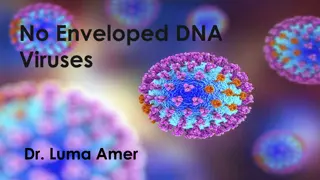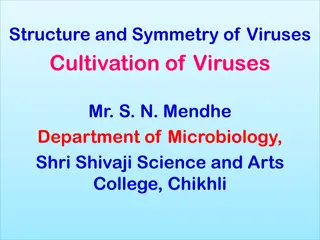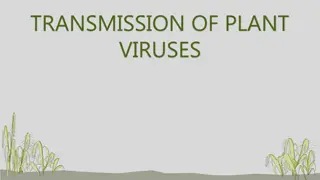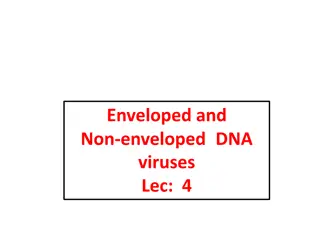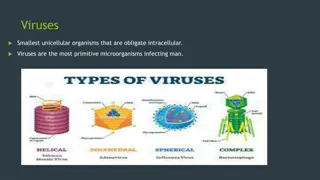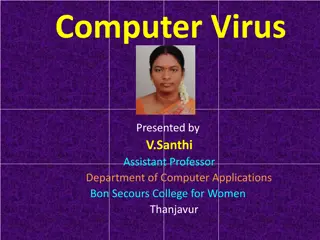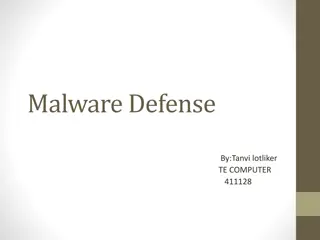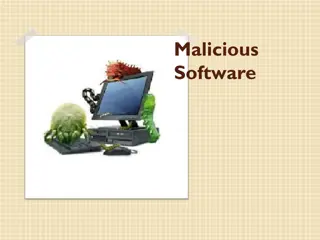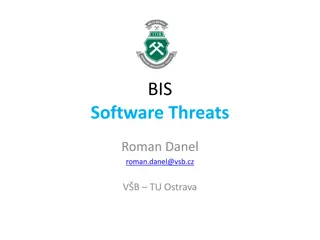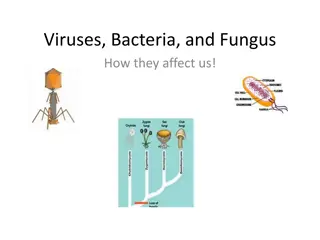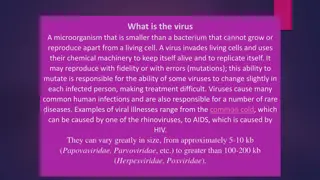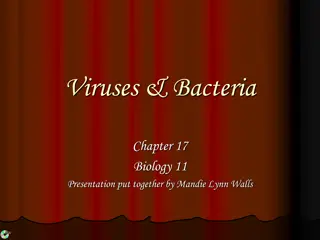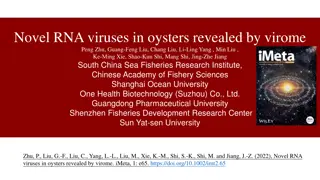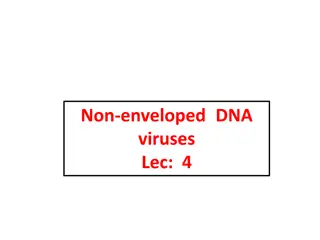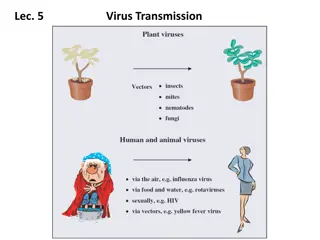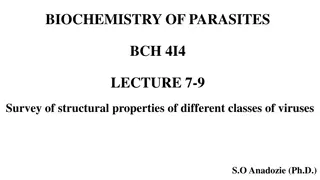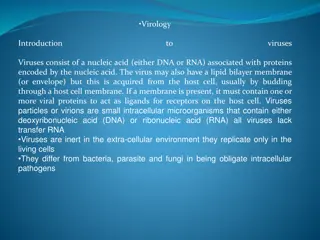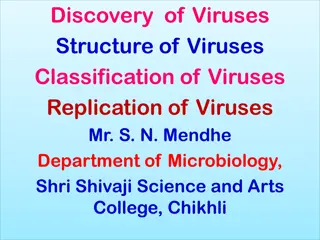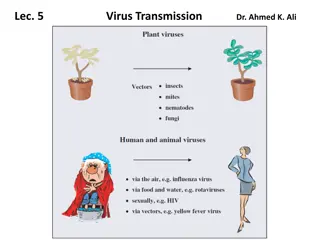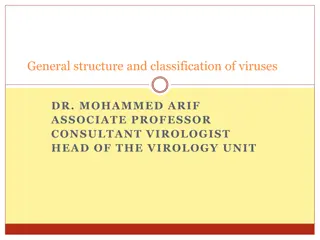Understanding Computer Organization and Architecture
A computer system is a programmable digital electronics device that processes data as per program instructions to provide meaningful output. It comprises hardware and software components, with hardware being the physical parts and software essential for driving the hardware. Computer organization fo
14 views • 71 slides
Understanding Viral Pathogenesis: Insights into Disease Development
Viral pathogenesis explores the intricate relationship between viruses and their hosts, encompassing factors like viral effects on cells, entry mechanisms, tissue tropism, immune responses, and the outcomes of infection. This process involves a series of interactions leading to either virus clearanc
1 views • 29 slides
Understanding Virus-Cell Interactions: Mechanisms and Consequences
Viruses interact with host cells in various ways, encoding genes that manipulate cell functions for their benefit. These interactions can range from benign to lethal outcomes. Factors influencing these interactions include viral factors, cellular responses, and the presence of virulence factors. Dif
0 views • 37 slides
Understanding No Enveloped DNA Viruses: Papillomaviruses and Polyomaviruses
Explore the characteristics and implications of no enveloped DNA viruses, such as Papillomaviruses causing common warts and Polyomaviruses inducing tumors in animals. Learn about their genetic properties, potential for carcinogenesis, and infections in different host systems.
6 views • 18 slides
Understanding Viruses, Viroids, and Prions: A Comprehensive Overview
Explore the fascinating world of viruses, viroids, and prions, from their discovery to their genetic material and hosts. Learn about the structure, genome, and sizes of viruses, as well as their interactions with different host cells. Gain insights into these acellular disease-causing agents and the
0 views • 17 slides
The Origin of Viruses: Theories and Evidence
Viruses are acellular parasites with a complex replication mechanism. Studies on their origin present challenges due to the lack of fossils. Three main hypotheses include regressive, cellular origin, and co-evolution. The regressive hypothesis suggests viruses originated from complex ancestors that
2 views • 25 slides
Understanding the Structure and Symmetry of Viruses along with Cultivation Methods
Viruses, defined as obligate intracellular parasitic organisms, exhibit general properties such as small size, filterability, simple structure, and absence of cellular components. They vary widely in size and lack independent metabolism. The cultivation of viruses plays a crucial role in studying th
3 views • 37 slides
The Transmission and Movement of Plant Viruses
Plant viruses are transmitted through various means such as cell-to-cell movement via plasmodesmata and systemic spread through vascular tissues. The viral proteins and mechanisms facilitating these movements are crucial for viral infection and spread within plant hosts. Understanding the different
0 views • 47 slides
Understanding Enveloped and Non-enveloped DNA Viruses
Non-enveloped DNA viruses, surrounded by a protein capsid, are resistant to sterilization and thrive in acidic environments. Adenoviruses, a common non-enveloped type, spread through close contact and contaminated objects. Additionally, Papilloma and Polyoma viruses, causing persistent infections an
0 views • 23 slides
Understanding Computer Architecture and Organization
Computer architecture and organization are fundamental aspects of computing systems. Computer architecture focuses on the functional design and implementation of various computer parts, while computer organization deals with how operational attributes come together to realize the architectural speci
3 views • 40 slides
Computer Science Department Information and Courses Offered
The Computer Science Department provides information on courses offered for GCSE or BTEC qualifications, specifically focusing on the AQA GCSE in Computer Science. The course equips students with valuable thinking and programming skills essential in the modern workplace, covering key concepts and pr
3 views • 7 slides
Understanding the Transmission of Viruses: Routes and Implications
Viruses are intracellular parasites that require transmission to a new host to evade immune responses. This transmission process, whether through respiratory droplets, fecal-oral routes, or sexual contact, is crucial in the viral life cycle. Different modes of transmission, such as horizontal and ve
0 views • 11 slides
Evolution of Algorithms and Computer Science Through History
The history of algorithms and algorithmic thinking dates back to ancient times, with the development of general-purpose computational machines by Charles Babbage in the 19th century marking a significant advancement. The term "computer science" emerged in 1959, encompassing theoretical computer scie
1 views • 39 slides
Understanding Viruses: Basics and Morphology
Viruses are the smallest unicellular organisms that are obligate intracellular. They lack cellular organization like bacteria, and their multiplication is complex. Viruses have either DNA or RNA and are classified based on their nucleic acid. Their structure includes nucleic acid and a capsid compos
0 views • 29 slides
Understanding Computer Viruses and Preventive Measures
Computer viruses are malicious software that can cause significant harm to your device by spreading through various means such as online downloads and email attachments. They can disrupt systems, leak data, and cause operational issues. Learn how to identify signs of a computer virus and prevent inf
1 views • 9 slides
Understanding Computer Viruses and Their Types
Computer viruses, created by malicious hackers, are programs that can replicate themselves and harm computer systems by damaging data files. They can cause various issues like slow response, crashes, and distorted graphics. Common virus types include time bombs, logical bombs, worms, and boot sector
0 views • 19 slides
Understanding Computer Viruses: Types, Prevention, and Top 5 Destructive Viruses
Computer viruses are malicious software programs that can cause significant harm. Learn about different types of viruses, symptoms of infection, stages of a virus, prevention measures, and the top 5 most destructive viruses of all time.
0 views • 11 slides
Effective Antivirus Approaches and Malware Defense Strategies
Antivirus approaches play a crucial role in combating malware threats. Prevention is key, followed by detection, identification, and removal of viruses. Generic Decryption technology aids in detecting complex polymorphic viruses without causing any harm to the computer. CPU emulator, virus signature
1 views • 22 slides
Understanding Malicious Software and Its Impact on Computer Systems
Malicious software, commonly known as malware, poses a serious threat to computer systems by exploiting vulnerabilities. This content covers various terminologies, categories, and types of malware, including viruses, worms, rootkits, spyware, and adware. It also delves into how malware can cause dam
0 views • 16 slides
Understanding Computer Viruses: Threats and Categories
Learn about computer viruses, their history, classification, and impact. Explore different types like file viruses, polymorphic viruses, and stealth viruses. Understand the categories based on impact and discover macroviruses related to office applications.
1 views • 47 slides
Protecting Your Computer and Laptop: Tips for Maintenance and Security
In this presentation, learn how to safeguard your computer and laptop with simple precautions to prevent physical damage, viruses, hacking, and more. Discover dos and don'ts for handling serious computer issues and ensuring your devices stay in optimal condition. Remember these key steps for maintai
0 views • 5 slides
Understanding Computer Crimes and Prevention Strategies
Computer crimes involve illegal acts utilizing computer systems, leading to various consequences. This lecture covers the types of computer system attacks, motives behind computer crimes, costs, prevention strategies, and reflection on the discussed topics. It emphasizes the increasing scope of comp
1 views • 20 slides
Understanding How Viruses, Bacteria, and Fungi Impact Human Health
Explore the intricate world of viruses, bacteria, and fungi and how they interact with living organisms. Learn about the structure and functions of viruses, the role of bacteria in diseases, and the implications of fungi on human health. Discover the different ways these microorganisms affect us and
0 views • 37 slides
Understanding Viruses: Origin, Structure, and Importance in Research
Viruses are microscopic organisms that rely on living cells to replicate and cause a range of illnesses in humans, animals, and plants. Studying viruses has led to significant scientific breakthroughs, providing insights into essential biological mechanisms and disease processes. Theories on the ori
0 views • 20 slides
Understanding Viruses and Bacteria: A Biology Presentation by Mandie Lynn Walls
Explore the world of viruses and bacteria through this engaging biology presentation put together by Mandie Lynn Walls. Learn about the structure of viruses, different types of viruses like T4 Bacteriophage and Herpes Virus, the distinction between viruses and bacteria such as E. coli, vaccination m
0 views • 39 slides
Novel RNA Viruses in Oysters Revealed by Virome Study
Oysters, as high-yield mariculture varieties, were investigated for novel RNA viruses using virome analysis. Eighteen new RNA viruses were identified, with evidence of genetic recombination. This study highlights the importance of advanced sequencing technologies in discovering viral pathogens in aq
0 views • 11 slides
Overview of Poxviridae Family: Structure, Classification, and Genus Details
Poxviridae is a family of large viruses known for causing vesicular skin diseases in both animals and humans. This family includes various poxviruses of veterinary and medical importance, each classified under different subfamilies and genera like Orthopoxvirus and Capripoxvirus. The viruses possess
0 views • 44 slides
Overview of Myxoviruses: Classification, Morphology, and Orthomyxoviridae
Myxoviruses are a group of viruses that bind to mucin receptors on red blood cells, causing hemagglutination. They are classified into orthomyxoviridae and paramyxoviridae, with influenza viruses being major pathogens. Influenza viruses consist of three genera and have distinct morphological feature
0 views • 25 slides
Unveiling the Intriguing World of Ancient Retroviruses and Human Evolution
Exploring the fascinating realm of ancient retroviruses, evolutionary biologists are resurrecting extinct deadly viruses to study their impact on human evolution and modern diseases. By investigating the genetic material of viruses, particularly endogenous retroviruses, researchers aim to trace evol
0 views • 13 slides
Decades of Marine RNA Virosphere Research
Research spanning over two decades has delved deep into the marine RNA virosphere, shedding light on the complex marine ecosystem and the characteristics of RNA viruses. Discoveries in deep marine virus taxonomy have led to significant taxonomic changes and advancements in virus classification and g
0 views • 10 slides
Exploring the Fundamentals of Plant Pathology: Understanding Viruses in Plant Diseases
Delve into the world of plant pathology with Mr. Vikash Kumar, as you learn about the nature, structure, and transmission of viruses affecting plants. Explore the important characteristics of plant viruses, their unique properties, and how they interact within plant cells. Gain insights into viral d
0 views • 14 slides
Overview of Non-Enveloped DNA Viruses and Their Impact on Human Health
Non-enveloped DNA viruses are surrounded by a protein coat called a capsid, making them difficult to sterilize and highly resilient in various environments. This article explores the characteristics and impact of non-enveloped DNA viruses such as Adenoviruses, Papilloma and Polyoma Viruses, and Huma
0 views • 16 slides
Understanding Virus Transmission via Vectors
Viruses must be transmitted to new hosts for their survival. This transmission occurs through vectors like arthropods, which acquire and transmit viruses during feeding. The mechanism involves viruses attaching to the vectors' mouthparts or entering their circulatory system to reach salivary glands
0 views • 14 slides
Survey of Structural Properties of Different Classes of Viruses
Viruses are small obligate intracellular parasites that require living hosts for multiplication. They lack ribosomes and metabolic enzymes, relying on host cells for replication. Viruses vary in size, shape, and genome organization, with classification based on morphology, physicochemical properties
0 views • 31 slides
Understanding Viruses: A Brief Overview of Virology
Viruses are small intracellular microorganisms consisting of nucleic acid and proteins, often enclosed in a lipid bilayer membrane acquired from host cells. They lack cellular structure and organelles and rely on host cells for replication. Control measures for viruses include leveraging knowledge o
0 views • 20 slides
Discovery and Classification of Viruses: Milestones in Virology History
Russian biologist Dimitry Ivanovsky's 1892 discovery of viruses through a Chamberland filter, followed by Martinus Beijerinck's 1898 identification of filterable, non-cultivable agents as viruses, marked key milestones in virology. The subsequent work of Beijerinck, Twort, and d'Herelle further adva
0 views • 19 slides
Understanding the Basics of Virology: Viruses, Viroids, and Prions
Virology explores the world of viruses, infectious agents with living and nonliving characteristics. Viruses, noncellular genetic elements, depend on host cells for replication and lack metabolic functions on their own. Viroids and prions are novel entities related to viruses. Viruses are classified
0 views • 31 slides
Understanding Virus Transmission via Vectors in Hosts
Viruses must be propagated and transmitted to new hosts for survival. They can be spread via vectors like arthropods, which acquire and transmit viruses during feeding. This transmission can occur quickly through the vector's mouthparts or more slowly via circulation in the vector's body. Plant viru
0 views • 14 slides
Arboviruses: A Comprehensive Overview of Arthropod-Borne Viruses
Arboviruses, transmitted by bloodsucking arthropods, are a diverse group of RNA viruses with varied classifications like Togaviridae, Flaviviridae, Bunyaviridae, Reoviridae, and Rhabdoviridae. In India, Dengue, Chikungunya, and Japanese Encephalitis are prevalent arboviruses. Togaviridae, including
0 views • 70 slides
Overview of Virus Structure and Classification
Viruses were first observed by Edward Jenner in 1798, who noticed their role in providing immunity. They are smaller than bacteria and consist of genetic material surrounded by a protein coat. Viruses are obligate cellular parasites, replicating only inside living cells. The structure of viruses inc
0 views • 38 slides



